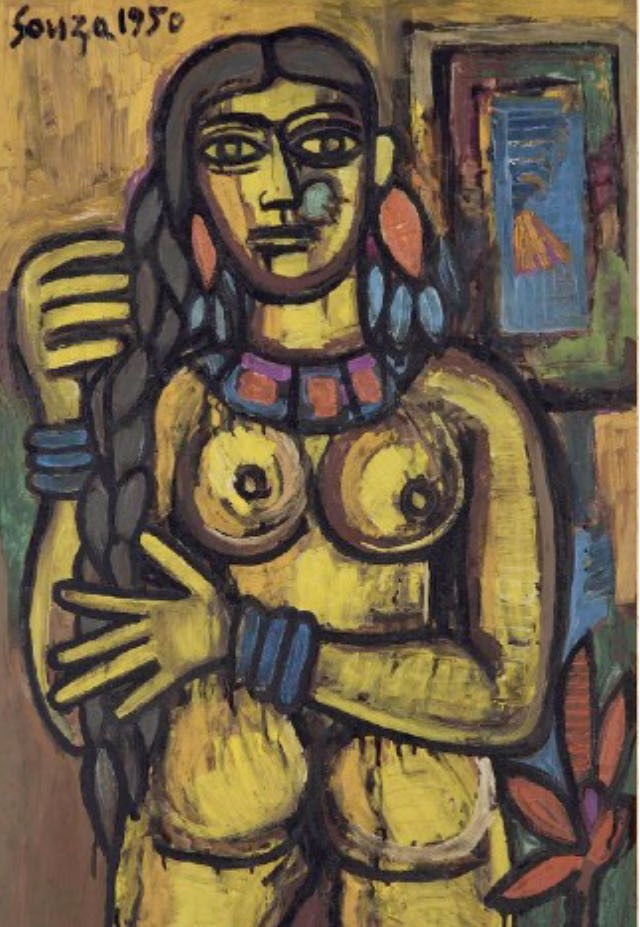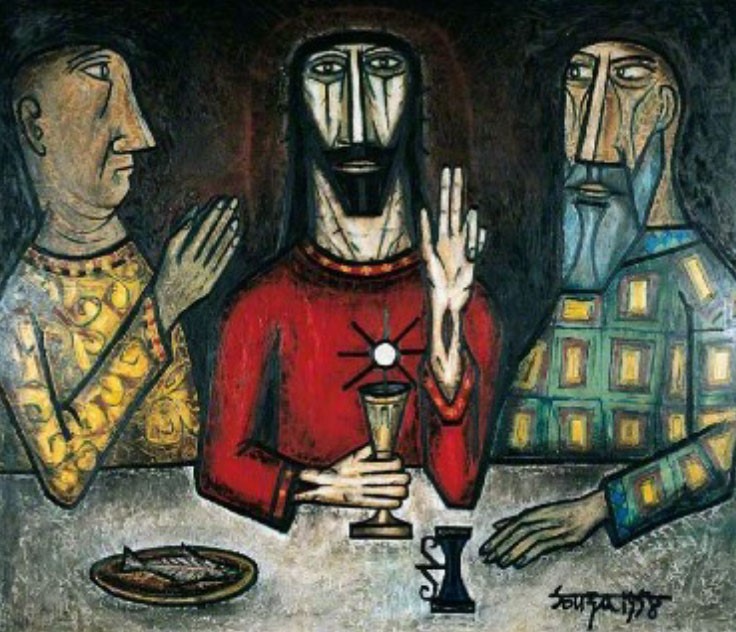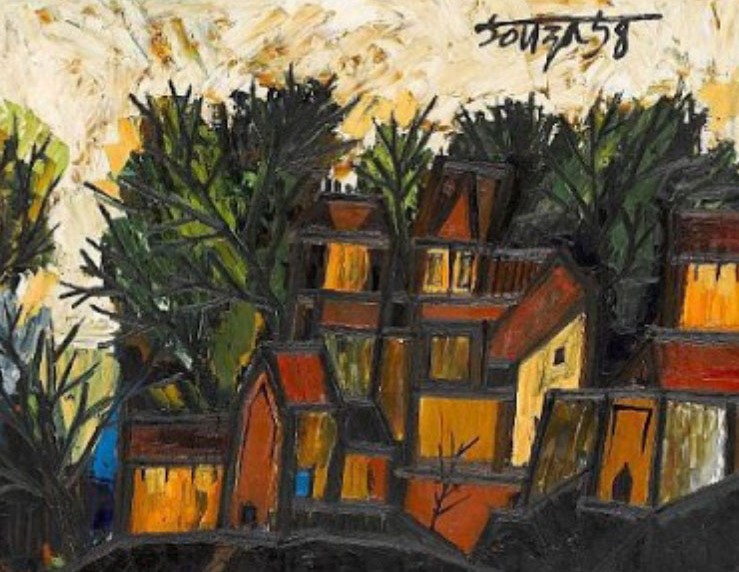12th April, ON THIS DAY
“Drawing is the core of my kingdom and madness, it is the focus of my vision of the world. I draw constantly, I don’t care about the paper, I just need a sheet to unravel my urges.”
– F.N Souza
Francis Newton Souza (F.N. Souza) was born in 1924 in Goa, India. He was brought up in a Portuguese Catholic colony in Goa and moved with his mother to Bombay where he really began his artistic journey. He studied at St. Xavier’s High School and developed an interest in studying oleographs, prints, paintings and drawings imported from Europe. He was a rebellious and precocious child who was expelled at the age of 15 for drawing and painting human obscenities and nudes in the school toilets.
Later, his interest led him to the Sir J.J. School of Art in Bombay, and he was expelled from there along with 21 others for joining Gandhi\’s Quit India Movement. His paintings depicted harsh realities, and he painted The Blue Lady (1945) on the day of his suspension from college. This work is regarded as a milestone in Indian modern art, it was painted with pigment squeezed directly from the tube and spread on canvas with a palette knife. It was an angry impulsive portrait, and in painting it he discovered the way he wanted to be portrayed. Eventually, Souza decided not to return to art school to complete his studies.

Souza wanted a specialized audience and environment for his work; therefore, he left for London in 1949. His journey was not easy, and he had to go through various hardships during his first few years in London. London lost its hold of artistic values after the Second World War and Souza found it even more difficult to establish himself as an artist.
Francis Newton Souza Artworks
From the early 1950s, he began exploring controversial themes like sex and religion. Souza’s career was stretched over six decades throughout which he tasted success and popularity with his stronghold of figurative and line paintings. Even though he experimented a lot with genres and styles, it was his series of “black paintings” that became most famous during the 1950s and ‘60s. He also indulged in using repetitive themes and motifs, including Catholicism, the female nude, and the dichotomy between good and evil. His works are characterized by a visceral, evocative sensuality that can sometimes be violent, and sometimes sexual.
 Francis Newton Souza Paintings. Picture courtesy: http://www.fn-souza.com/
Francis Newton Souza Paintings. Picture courtesy: http://www.fn-souza.com/
Maria, Souza’s wife, was the only bread earner during his initial six years in Europe as Souza struggled to earn and support himself financially with his occasional exhibitions and shows throughout his journey. Souza was not only a master painter but a brilliant author as well.
He wrote his semi-autobiographical essay in the book Words and Line in July 1959. Souza’s perspective of portraying reality, especially the female nudes, religious scenes, and landscapes, were among his favourite themes which he explored using black as a basic colour to reflect his monochromatic vision of his and further explored the relationship between the ominous and sublime aspect of nature and beauty in his work. His psychological thought was to understand, explore and implore the possibility of connecting nature, man and god. His work shows his affection and inspiration for Pinturas Negr as by Francisco de Goya and the monochromatic works of conceptual artist Yves Klein, whom he most likely encountered when Klein exhibited at Galerie Iris Clert in Paris in the 1950s and ’60s.
Souza’s early pursuits, which included his experimental work, failed to win the attention of the patrons, and due to this he travelled around Europe to be united with his fellow painters like S.H. Raza and Akbar Padamsee and met Pablo Picasso for the first time in Paris where he got to see his work and the encounter changed him and as he defined it himself as the defining moment of his career.
Despite the grotesque subject matter, this is an unusual quarter-length work for Souza, depicting a terrifying subject at the same time. The rich impasto is broken up with thick black lines, revealing an elongated flat snout like that of an African tribal mask, reflective of a menacing mask. With a chalky background, Souza emphasizes the dynamism and vitality of his subject and features.
 Francis Newton Souza Paintings. Picture courtesy: http://www.fn-souza.com/
Francis Newton Souza Paintings. Picture courtesy: http://www.fn-souza.com/
The brilliant intricacies of a culture fascinated F.N. Souza, who rejected the dogmas of religion but has frequently sought Christianity as a muse and source of inspiration. His paintings depict the life of Christ in still lives and representations of the liturgy of Communion to Old Testament stories. In the record-breaking artwork, ‘Birth’, a priest holds vigil for a nude labouring woman as she gives birth. References might be at the centre of the composition, such as the unsettling renditions of The Crucifixion. A particularly ominous iteration of the Crucifixion theme appears in 1963 when the artist was working in London. A cadaverous martyr faces us in Last Howl from the Cross, his face distorted into a grimace, as his acolytes gather around the cross, disfigured and refashioned. Souza painted as well as wrote about Goa\’s idyllic villages, marvelling at the images of Christ and Madonna on the walls of Roman Catholic houses, candles on the altar, and arabesques on the fading walls. Souza had a complicated relationship with Christianity as the son of a Roman-Catholic family of Konkan origin.
In spite of Souza’s mother\’s wish for him to be a priest, he found his joy in art. However, his fascination with the spectacle of the Roman Catholic Church remained unwavering even as he struggled to find an unquestioning faith in religion or its practitioners. Later he would write, “As a child, I was fascinated by the grandeur of the church and by the stories of tortured saints that my grandmother used to tell me. As far as I can recollect, strange fancies always occupied my mind.”
It was the visual culture of Catholicism that informed his work even after he had repudiated the faith later in life. Christie\’s has sold many religious iconography paintings by Souza, such as Untitled (The Prophet) (1955), Untitled (Still Life with Fish), 1961, Black Pope (1965) and Untitled (Flagellation of Christ) (1965).
Read Also:

Contributor





